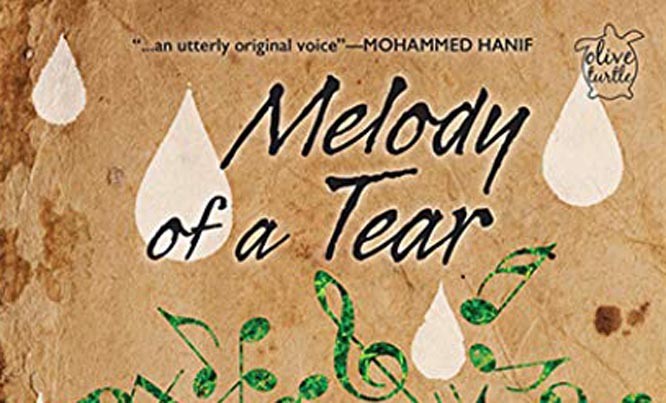
Haroon Akhtar’s debut novel is the complex story of a conflicted person on a quest for self-expression

English fiction by Pakistani writers is experiencing a revival, and the latest offering is Melody of a Tear by Haroon Khalid Akhtar. Akhtar’s debut novel is the complex story of a conflicted person, Zara, on a quest for self-expression.
Zara’s dilemma is the schism between her self-identity and social identity. Raised as a boy by her autocratic father, Zara suffers from the parental directive that most Pakistani male children hear often: "Boys don’t cry". A lifelong suppression of emotions prevents Zara from expressing that most basic of human emotions, the ability to cry. Thus begins the story of her search for the impetus that will break this emotional deadlock.
Zara is the unconventional protagonist of this introspective tale. Female by gender and male by parenting influence, Zara exists in an enforced limbo of androgyny. There is no hero. There exists only a trio of unremarkable personalities whose shortcomings are used by the author to structure a story of dualities. Using a writer’s liberty in shaping characters, Akhtar bestows the two male protagonists, Zaid and Waris, with otherworldly powers. Much like a superhero, Zaid is conferred the ability to soak the unhappiness and misery of others to altruistically lessen their emotional burdens. Waris, the ailing crime-fiction writer, is Zara’s unlikely mentor who almost achieves god-like omnipresence in guiding the storyline.
The concept of binaries pervades the story from the start and is strengthened until the end. Public and private personas clash as the story progresses. There is an emphasis on a deliberate distancing from the past, something that the characters are never fully able to achieve in their lives. Death is thus highlighted as the one true path to freedom from turmoil.
Borrowing elements of magical realism, Melody of a Tear is centred on Zara’s obsessive fascination with an acquaintance’s ease in shedding a tear. The title hints at the melancholic story to follow, and the reader is not disappointed. Akhtar’s novel is populated by characters that exhibit a lack of capacity to express feelings. Each character, whether it is the central figure of Zara or the brief sketches of her parents, highlights the struggle to emote. Even Zaid, the sensitive soul whose ability to empathise fascinates Zara, is shown throughout to maintain a poker face. The one exception is the boisterous character of Sheila, a poor Hindu woman single-handedly raising a brood of four sons in the backyard.
Sheila’s uniqueness does not only reside in her expressive personality. She is the multiethnic representation of Karachi, the city that moors the action of the story. Sheila’s circumstances are also a comment on the state of the underprivileged section of society. Akhtar does not dwell on religious differences. In fact, for a novel about a Pakistani woman that is set in Pakistan, the novel is refreshingly free from religious commentary that inadvertently seeps into Pakistani literature. Instead, Akhtar stresses upon the lamentable universality of socio-economic discrimination that the poor face.
Poverty runs as an undercurrent throughout the novel. Whether it is economic poverty or the poverty of affection, the novel paints a gloomy portrait of modern society. Karachi is depicted as a sprawling and disjointed space, indifferent towards the plight of its poor and underprivileged. The conclusion, too, draws upon the city’s apathy to resolve Zara’s quandary and provide a semblance of reality to its tale of ambiguities.
A crumbling mansion, known as Sofaid Kothi, provides the setting for Zara’s search for past influences in present-day Karachi. Symbolism is rife in this ambitious take on magical realism and the protagonist’s pull towards the ruins of the house signifies the constant attraction of the past. The mansion’s progressive dilapidation represents the breakdown of relationships and order in the novel. Akhtar utilises the stylistic feature of a story within a story to bridge the gap between the past and the present. Meant to lend coherence to the plot, this literary trick, unfortunately, creates the impression of the story being needlessly dramatised.
Whether intentional or not, ambiguity becomes the heart of the novel. Confusion prevails throughout, leaving the reader with more questions at the end than at the outset. It is never clear whether Zara’s intense focus on achieving the ability for emotional expression is driven by her desire to reclaim her repressed womanhood, or by a higher purpose of empathy for others. Unravelling Zaid’s story is the novel’s stated purpose yet it is the search of closure for Waris’s story that takes precedence later. The beginning negates the ending, and the entire fantastical plot is reduced to the possibility of mere hallucinations by a device as prosaic as mental illness.
Akhtar’s debut novel is an ambitious departure from the usual literary fare. Structured in two parts with chapters that define Zara’s journey to self-actualisation, Melody of a Tear is an interesting addition to Pakistani literature in English.
Melody of a Tear
Author: Haroon Khalid Akhtar
Publisher: Niyogi Books
Pages: 212
Price: Rs750